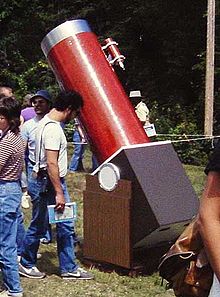
A Dobsonian telescope is an altazimuth-mounted Newtonian telescope design popularized by John Dobson in 1965 and credited with vastly increasing the size of telescopes available to amateur astronomers. Dobson's telescopes featured a simplified mechanical design that was easy to manufacture from readily available components to create a large, portable, low-cost telescope. The design is optimized for observing faint, deep-sky objects such as nebulae and galaxies. This type of observation requires a large objective diameter (i.e. light-gathering power) of relatively short focal length and portability for travel to less light-polluted locations.[1][2]
Dobsonians are intended to be what is commonly called a "light bucket".[3][a] Operating at low magnification, and therefore the design omits features found in other amateur telescopes such as equatorial tracking. Dobsonians are popular in the amateur telescope making community, where the design was pioneered and continues to evolve.[1] A number of commercial telescope makers also sell telescopes based on this design. The term Dobsonian is currently used for a range of large-aperture Newtonian reflectors that use some of the basic Dobsonian design characteristics, regardless of the materials from which they are constructed.[4]
- ^ a b Newton, Jack; Teece, Philip (19 January 1995). The Guide to Amateur Astronomy. Cambridge University Press. p. 287. ISBN 9780521444927.
- ^ Ferris, Timothy (8 July 2003). Seeing in the Dark. Simon and Schuster. p. 39. ISBN 9780684865805.
- ^ Allison, Mark (21 December 2005). Star Clusters and how to Observe Them. Springer. p. 74. ISBN 9781846281907.
- ^ Cite error: The named reference
levywas invoked but never defined (see the help page).
Cite error: There are <ref group=lower-alpha> tags or {{efn}} templates on this page, but the references will not show without a {{reflist|group=lower-alpha}} template or {{notelist}} template (see the help page).